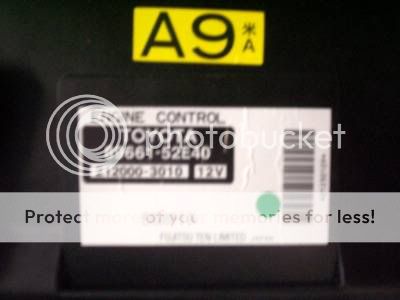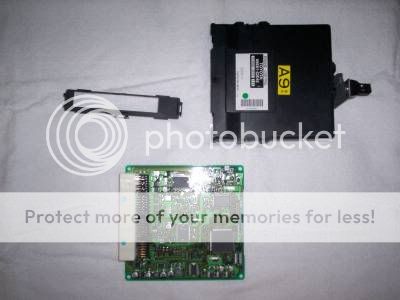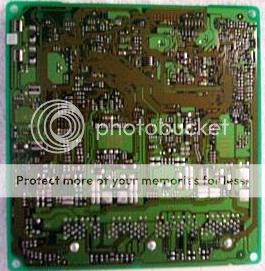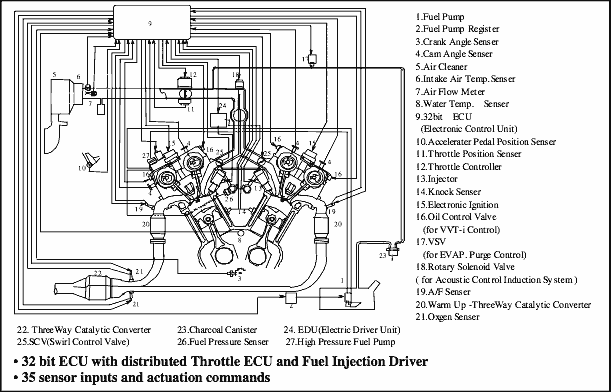You say 64bit learning ECU, prove it.
#41
(1) No one suggested the "Door Lock Control Relay" was a $485 unit - it was just being used as an example of how much more complex than expected some of the little 'black boxes' are. (Actually it's a blue box and $425 retail...  )
)
(2) All Scions are "50 state."
(3) The most recent info I have found on Toyota ECU CPUs seems to indicate that they are 32 bit, 200Mhz units... (That is still not Scion specific, but the hardware is likely the same, even if the software is model specific.)
Still looking, but not that hard...
__________________
Things like the Door Lock Control Relay are insanely expensive for several reasons: The cost of development/design/manufacture is spread over a relatively small number of units, the warehousing of a few million spare parts for hundreds of car models a decade at a time is, uh, "complex and expensive," and finally, because it is a closed market - they can get away with charging that much - you can't run down to RadioShack and get a cheap replacement - you MUST use their unit, or an even more expensive custom-made unit. :D
Even cell phones are more complex, but cheaper. This is because the actual transceiver is a commodity circuit pack incorporated into many millions of phones of different models, and even the non-common circuits and cases are often done up in millions of units. Spreading a couple million dollars on development and another million dollars on production tooling/setup over millions of units affects costs less than trying to pay for that over a hundred thousand units and spares.
Also, with most consumer electronics, like cellphones, there is no massive backstock of spare parts required by law (for models sold in the US, the manufacturer must maintain adequate spares to support any given model for a minimum of seven years).
Anyway, there are many legit reasons why the actual cost of things like car black boxes appears higher than some "equivalent" other consumer electronics, plus the eventual retail price of those automotive units can be marked up even more just "because they can." :D
 )
)(2) All Scions are "50 state."
(3) The most recent info I have found on Toyota ECU CPUs seems to indicate that they are 32 bit, 200Mhz units... (That is still not Scion specific, but the hardware is likely the same, even if the software is model specific.)
Still looking, but not that hard...

__________________
Things like the Door Lock Control Relay are insanely expensive for several reasons: The cost of development/design/manufacture is spread over a relatively small number of units, the warehousing of a few million spare parts for hundreds of car models a decade at a time is, uh, "complex and expensive," and finally, because it is a closed market - they can get away with charging that much - you can't run down to RadioShack and get a cheap replacement - you MUST use their unit, or an even more expensive custom-made unit. :D
Even cell phones are more complex, but cheaper. This is because the actual transceiver is a commodity circuit pack incorporated into many millions of phones of different models, and even the non-common circuits and cases are often done up in millions of units. Spreading a couple million dollars on development and another million dollars on production tooling/setup over millions of units affects costs less than trying to pay for that over a hundred thousand units and spares.
Also, with most consumer electronics, like cellphones, there is no massive backstock of spare parts required by law (for models sold in the US, the manufacturer must maintain adequate spares to support any given model for a minimum of seven years).
Anyway, there are many legit reasons why the actual cost of things like car black boxes appears higher than some "equivalent" other consumer electronics, plus the eventual retail price of those automotive units can be marked up even more just "because they can." :D
#42
This is a good thread, but comparing costs of electronics seems to be getting us off topic. Even a 16 bit ECU could do most of the things we're discussing.
What I want to know is how we can assume that this ECU can limit torque to a certain level (regardless of the # of BITS that it's capable of running.)
I mean, I guess the ECU could always run the injectors at a given duty cycle and always pull timing at a certain RPM, but suppose you change mechanical things that aren't monitored or controlled by the computer? Would you say that there are accelerometers and timers inside that are saying "Whoa...that 1/4 miles was just WAY too fast...I'm going to cut the power back a little."
Like what if you increase fuel pressure somehow or change injector size? Then the injector is still sending more fuel, despite the limit on pulse width. Then the 02 sensor sees a richer mixture and modifies the pulse width some more. How much can it really compensate, though, if you get more air AND more fuel in so the O2 still sees the ratio it's expecting? Remember that an O2 sensor only reads the mixture, not the volume of gas.
What if you change air delivery somehow (larger TB, bigger/more/shorter/longer intake runners/FI etc)? Sure, the MAF can read that and say "you're getting too much air...I better do something." But really, how much can it do? It can't mechanically close the throttle (I don't think scions will ever get "drive by wire")...it's just referring to different maps. What if you translated the MAF signals into what the ECU is expecting even if you're passing more air? The turbo Buick and other 'muscle car' guys do this all the time.
Even if this thing 'learns' how to kill power, there has to be ways around it by making systems more efficient and 'lying' to other systems in the ECU.
Also, don't forget that things like excessive noise from a header could be inaccurately translated as "knock" and a signal would be sent to pull timing. Things like this could result in power loss from a mod.
Keep the info coming...I've got a hundred more questions!
What I want to know is how we can assume that this ECU can limit torque to a certain level (regardless of the # of BITS that it's capable of running.)
I mean, I guess the ECU could always run the injectors at a given duty cycle and always pull timing at a certain RPM, but suppose you change mechanical things that aren't monitored or controlled by the computer? Would you say that there are accelerometers and timers inside that are saying "Whoa...that 1/4 miles was just WAY too fast...I'm going to cut the power back a little."
Like what if you increase fuel pressure somehow or change injector size? Then the injector is still sending more fuel, despite the limit on pulse width. Then the 02 sensor sees a richer mixture and modifies the pulse width some more. How much can it really compensate, though, if you get more air AND more fuel in so the O2 still sees the ratio it's expecting? Remember that an O2 sensor only reads the mixture, not the volume of gas.
What if you change air delivery somehow (larger TB, bigger/more/shorter/longer intake runners/FI etc)? Sure, the MAF can read that and say "you're getting too much air...I better do something." But really, how much can it do? It can't mechanically close the throttle (I don't think scions will ever get "drive by wire")...it's just referring to different maps. What if you translated the MAF signals into what the ECU is expecting even if you're passing more air? The turbo Buick and other 'muscle car' guys do this all the time.
Even if this thing 'learns' how to kill power, there has to be ways around it by making systems more efficient and 'lying' to other systems in the ECU.
Also, don't forget that things like excessive noise from a header could be inaccurately translated as "knock" and a signal would be sent to pull timing. Things like this could result in power loss from a mod.
Keep the info coming...I've got a hundred more questions!
#43
This is a good thread, but comparing costs of electronics seems to be getting us off topic.
#45
I suggest this, if you BoogieQ don't believe the ecu has its issues in reguarding boost, you prove to everyone else it isn't. Yes, i'm calling you out. Learning ecu's have huge limitations compared to other ecu's and programs out there, you started this thread asking people to prove it is the problem. Now i start the question, how isn't it the problem? And if you don't believe it is the problem, what problems do you see causing past issues with our 1nz? Yes, for a while there people either had bad luck with tuning, or believed what xxx said about tuning, and ended up being a very poor, costly tune. Thats a unavoidable issue being that it happens everywhere, not just scions/toyota, everyone. N/a too.
I'm not saying boosted 1nz's can't make power, any boosted motor can. But the limit that we are able to succeed without issues caused by the ecu, as well as a few others, are strict.
I'm not saying boosted 1nz's can't make power, any boosted motor can. But the limit that we are able to succeed without issues caused by the ecu, as well as a few others, are strict.
#46
If the ecu uses table driven code to control the injection then the table can limit the amount of fuel that it can inject at a certain rpm because the table is a realistic size and would not have entries for more fuel injection at levels that it should not normally operate at i.e. 20lbs boost so yes the ECU could limit power output. If you required more fuel than the table allows then when that limit was reached the mixture might lean out then the oxygen sensor might trip from too lean a mixture and all sorts of things could / might happen. I was told by someone that knows a lot about these engines that when they get a little too warm the fuel mixture is enriched to cool down the engine. Imagine that!
As far as ABS brakes go on the xB at least it is controlled more by the computer than in prior older cars because the stability control operates the brakes to each wheel independant of the brake pedal when it needs to - a lot more complicated than OLD cars ABS systems. I am not trying to prove that a 64 bit is being used just that it could be very likely. Now show me a photo of the board that it is on and I could probably figure out what it was and I am pretty sure that it would NOT be some really rare chip but likely a readily available chip that has a low cost and is easy to program with lots of high level language software support from the industry.
As far as ABS brakes go on the xB at least it is controlled more by the computer than in prior older cars because the stability control operates the brakes to each wheel independant of the brake pedal when it needs to - a lot more complicated than OLD cars ABS systems. I am not trying to prove that a 64 bit is being used just that it could be very likely. Now show me a photo of the board that it is on and I could probably figure out what it was and I am pretty sure that it would NOT be some really rare chip but likely a readily available chip that has a low cost and is easy to program with lots of high level language software support from the industry.
#47
Jan06xB's post makes a good point about the tables, but it goes back to my question: If there is a realistic limit to the # of tables or correction multiplyers, then a separate mechanical means of getting more fuel to the engine (ie - additional injectors with separate controller and maybe even pump/regulator) is possible while still showing the O2 sensors an acceptable ratio.
And I think we'd all agree that nearly all EFI NA cars are limited somewhat by the ECU when adding forced induction. Weren't some of the boosted cars that had problems on this board running stand-alone efi, anyway?
Is the point of this thread only to find out if the computer is 64 bit or is it to find out what limitations it can cause???
Regarding modern ABS, most newer cars use a separate ABS computer. Are we even sure the Scion ABS is controlled by the engine ECU?
And I think we'd all agree that nearly all EFI NA cars are limited somewhat by the ECU when adding forced induction. Weren't some of the boosted cars that had problems on this board running stand-alone efi, anyway?
Is the point of this thread only to find out if the computer is 64 bit or is it to find out what limitations it can cause???
Regarding modern ABS, most newer cars use a separate ABS computer. Are we even sure the Scion ABS is controlled by the engine ECU?
#49
Actually the Engine Control Unit seems to be directly involved with managing the ABS/VSC/TRAC systems, but gets some help from an aux controller for the VSC. Here are the basic schematics:
Engine Control PDF
About the forced induction cars being limited by the lookup tables (maps) available to their ECUs, the fresh-from-the-factory ECU in the tC does NOT have tables that allow it to handle forced induction situations without being 'reflashed' to include a new set of tables that give extended instructions. Here's a discussion from the tC forums here...
https://www.scionlife.com/forums/viewtopic.php?t=98810
and
https://www.scionlife.com/forums/viewtopic.php?t=118496
Yeah, I know, that's about the tC, but it is still interesting info...
Engine Control PDF
About the forced induction cars being limited by the lookup tables (maps) available to their ECUs, the fresh-from-the-factory ECU in the tC does NOT have tables that allow it to handle forced induction situations without being 'reflashed' to include a new set of tables that give extended instructions. Here's a discussion from the tC forums here...
https://www.scionlife.com/forums/viewtopic.php?t=98810
and
https://www.scionlife.com/forums/viewtopic.php?t=118496
Yeah, I know, that's about the tC, but it is still interesting info...
#50
Well sombody asked for these,so i took it upon myself to tear the ECU out, i don't know if they will help. Sorry the pics aren't that great, junky digital camera and definatley not Tomas quality pics. But i tried 










#52
OK, that gives us a reasonable look at the contents of that 'black box.' 
I see it *IS* one of the units made by Fujitsu-Ten, so I'll toss out some info I've been going through from them. The reason I didn't toss this in the pot before, is it is not specifically the units used with our engine, but with other Toyota engines from the same design era. Since they are now confirmed to be all Fujitsu-Ten units, this should help, even though they are not the identical module.
http://tijil.org/16-4.pdf
http://tijil.org/26-1.pdf
Lastly, here's a single slide from a PowerPoint presentation given by some engineers from Toyota at the American Control Conference, 09JUN2005. It's a 'generic' Toyota ECU...

Enjoy, folks! :D

I see it *IS* one of the units made by Fujitsu-Ten, so I'll toss out some info I've been going through from them. The reason I didn't toss this in the pot before, is it is not specifically the units used with our engine, but with other Toyota engines from the same design era. Since they are now confirmed to be all Fujitsu-Ten units, this should help, even though they are not the identical module.
http://tijil.org/16-4.pdf
http://tijil.org/26-1.pdf
Lastly, here's a single slide from a PowerPoint presentation given by some engineers from Toyota at the American Control Conference, 09JUN2005. It's a 'generic' Toyota ECU...

Enjoy, folks! :D
#53
from Geek.com
n 1981 NASA sent up the first space shuttle, which used Intel 8086 processors for a host of diagnostic equipment. More than 20 years on these chips are still being used to make sure the shuttle's twin booster rockets are safe for blast-off,
from the Wiki on the 8086
<i>
The 8086 is a 16-bit microprocessor chip designed by Intel in 1978, which gave rise to the x86 architecture. The processor runs at clock speeds between 4.77 (as with the 8088 version used in the original IBM PC) and 10 MHz.
[/i]
So the shuttle is still using a 16 bit processor, that runs at 10 mhz. Realize that the average desktop packs almost 100 times that.
I I think 16 or 32 is all our little box really needs
n 1981 NASA sent up the first space shuttle, which used Intel 8086 processors for a host of diagnostic equipment. More than 20 years on these chips are still being used to make sure the shuttle's twin booster rockets are safe for blast-off,
from the Wiki on the 8086
<i>
The 8086 is a 16-bit microprocessor chip designed by Intel in 1978, which gave rise to the x86 architecture. The processor runs at clock speeds between 4.77 (as with the 8088 version used in the original IBM PC) and 10 MHz.
[/i]
So the shuttle is still using a 16 bit processor, that runs at 10 mhz. Realize that the average desktop packs almost 100 times that.
I I think 16 or 32 is all our little box really needs
#54
I forgot to mention the ECU in the pic's is from an 06, supposedly the pin confirguration from 03-05 has changed in the 06's, not sure if the ECU has changed it self inside. Just thought i would throw that out.
#55
so it seems like ECU is actually 32-bit?
you know I've been wondering for quite some time now... where exactly did anyone get the 64-bit ECU from anyway?
was it just something that was said in some post somewhere?
you know I've been wondering for quite some time now... where exactly did anyone get the 64-bit ECU from anyway?
was it just something that was said in some post somewhere?
#56
Originally Posted by sikbrik
Jan06xB's post makes a good point about the tables, but it goes back to my question: If there is a realistic limit to the # of tables or correction multiplyers, then a separate mechanical means of getting more fuel to the engine (ie - additional injectors with separate controller and maybe even pump/regulator) is possible while still showing the O2 sensors an acceptable ratio.
There are people out there that can hack into the code but it will be expensive.
#58
Originally Posted by Chimmy3
so it seems like ECU is actually 32-bit?
you know I've been wondering for quite some time now... where exactly did anyone get the 64-bit ECU from anyway?
was it just something that was said in some post somewhere?
you know I've been wondering for quite some time now... where exactly did anyone get the 64-bit ECU from anyway?
was it just something that was said in some post somewhere?
To the quote above, i would guess someone said it at one point and the community just took it as gospel. As much as we all like, not everything posted on a board is factual or accurate. I am sure in some of my ramblings I said something I thought to be true that wasn't. Heck, even typo's can cause it to happen.
Props to you all for digging into this.. I would be more likely to say 32 at this point. The processing prowess of this ECU isn't what I really was after.. everyone here (at least that was vocal about it) was blasting "64bit ecu" in everyones face and convinced they were right but nobody knew why or where that information came from.
Sorry to bring this back to the top after so long, just wanted to add my thoughts.. I think this is 99% case closed.. the 1% from something not stating XB and 32 bit in the same diagram
Continue on...
#60
Originally Posted by Sushiboy
So assuming th ECU is actualy 32 bit, where does that get us? Regardless, doesn't the ECU still compinsate for mods or is that a farse now?





